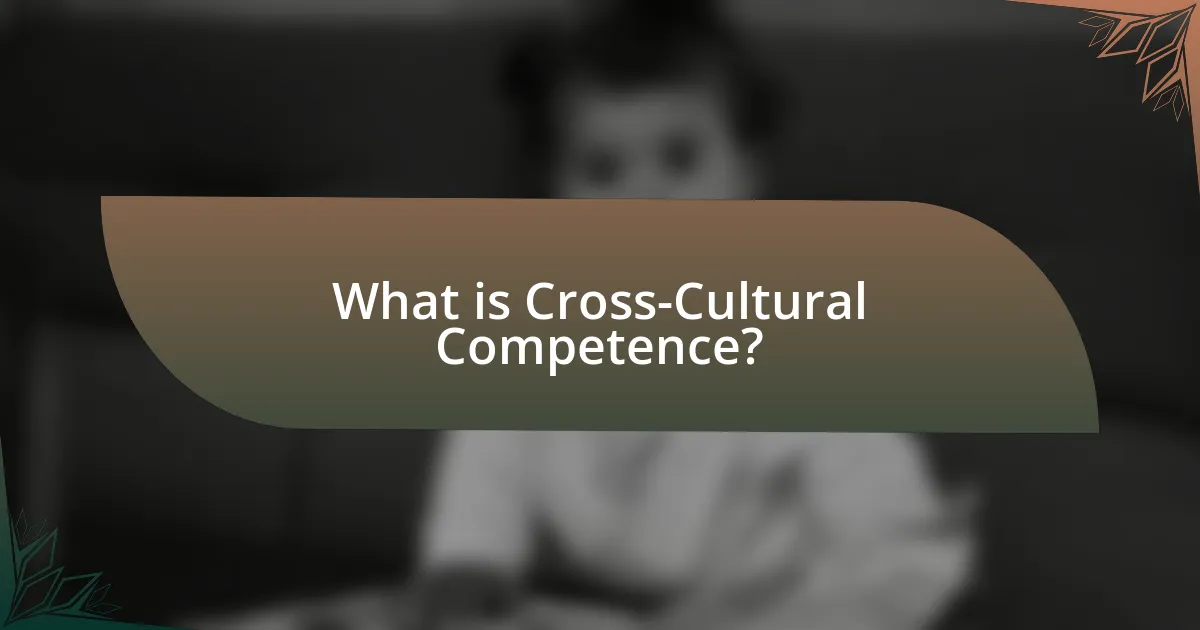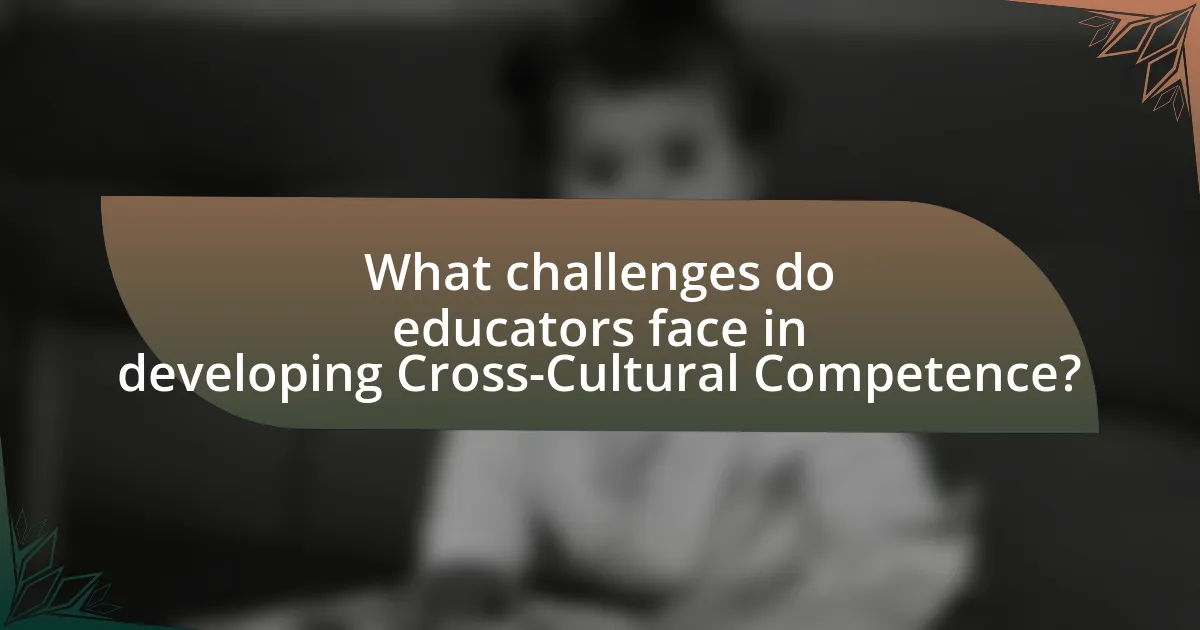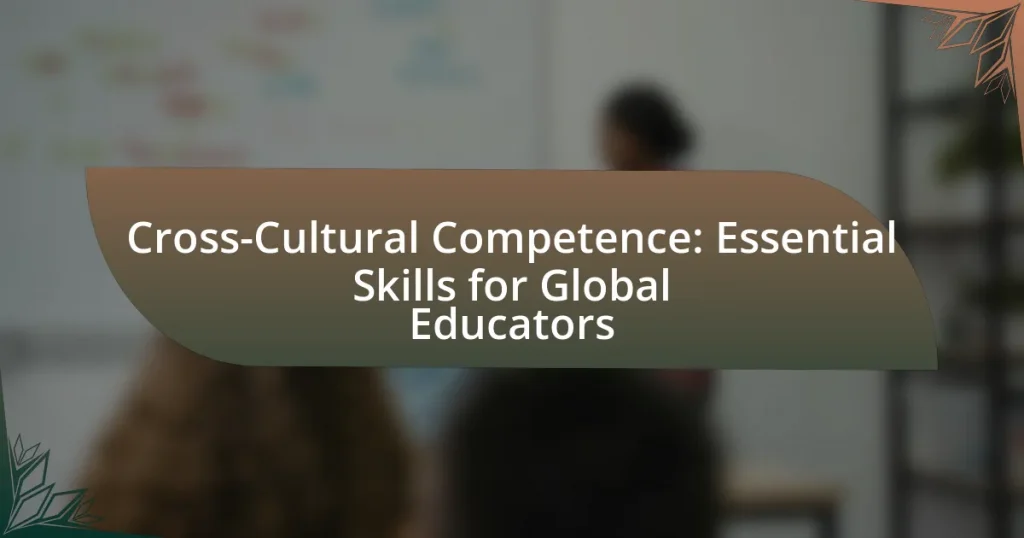Cross-Cultural Competence is defined as the ability to understand, communicate with, and effectively interact with individuals from diverse cultural backgrounds. This article explores the significance of cross-cultural competence for global educators, emphasizing its role in enhancing teaching effectiveness, student engagement, and fostering an inclusive learning environment. Key components of cross-cultural competence, such as cultural awareness, empathy, and adaptability, are discussed, along with strategies for educators to assess and develop these skills. Additionally, the article addresses challenges faced in cultivating cross-cultural competence and highlights best practices for creating inclusive educational settings that promote cultural understanding and respect.

What is Cross-Cultural Competence?
Cross-Cultural Competence is the ability to understand, communicate with, and effectively interact with people from diverse cultural backgrounds. This competence involves awareness of one’s own cultural worldview, knowledge of different cultural practices and worldviews, and the ability to adapt behavior and communication styles to different cultural contexts. Research indicates that individuals with high cross-cultural competence are better equipped to navigate multicultural environments, leading to improved collaboration and reduced conflict in global settings.
Why is Cross-Cultural Competence important for global educators?
Cross-Cultural Competence is important for global educators because it enables them to effectively teach and engage with diverse student populations. This competence allows educators to understand and respect cultural differences, which enhances communication and fosters an inclusive learning environment. Research indicates that culturally competent educators can improve student outcomes by tailoring their teaching strategies to meet the varied needs of students from different backgrounds, thereby promoting equity in education. For instance, a study published in the “Journal of Teacher Education” found that teachers who received training in cross-cultural competence reported increased effectiveness in addressing the needs of culturally diverse students.
How does Cross-Cultural Competence enhance teaching effectiveness?
Cross-Cultural Competence enhances teaching effectiveness by enabling educators to understand and respond to the diverse cultural backgrounds of their students. This understanding fosters an inclusive learning environment, which has been shown to improve student engagement and academic performance. Research indicates that culturally responsive teaching practices can lead to higher achievement levels among students from various cultural backgrounds, as they feel more valued and understood in the classroom. For instance, a study published in the “Journal of Educational Psychology” found that teachers who employed culturally relevant pedagogy saw significant improvements in student motivation and learning outcomes.
What role does Cross-Cultural Competence play in student engagement?
Cross-Cultural Competence significantly enhances student engagement by fostering an inclusive learning environment that respects diverse cultural backgrounds. This competence allows educators to connect with students on a personal level, making learning more relevant and relatable. Research indicates that students who perceive their cultural identities as valued in the classroom are more likely to participate actively and perform better academically. For instance, a study published in the “Journal of Educational Psychology” found that culturally responsive teaching practices, which are rooted in cross-cultural competence, lead to increased motivation and engagement among students from diverse backgrounds.
What are the key components of Cross-Cultural Competence?
The key components of Cross-Cultural Competence include awareness, knowledge, skills, and attitudes. Awareness involves recognizing one’s own cultural biases and understanding how they influence interactions with others. Knowledge encompasses understanding different cultural norms, values, and practices, which is essential for effective communication. Skills refer to the ability to adapt behavior and communication styles to fit diverse cultural contexts, facilitating better relationships. Attitudes involve openness and respect towards cultural differences, fostering a willingness to learn from others. These components collectively enhance an individual’s ability to navigate and engage in multicultural environments effectively.
What skills are essential for developing Cross-Cultural Competence?
Essential skills for developing cross-cultural competence include cultural awareness, empathy, adaptability, effective communication, and active listening. Cultural awareness allows individuals to recognize and understand cultural differences, while empathy fosters the ability to relate to others’ perspectives and experiences. Adaptability enables individuals to adjust their behavior and strategies in diverse cultural contexts. Effective communication skills are crucial for conveying ideas clearly and respectfully across cultures, and active listening ensures that individuals fully understand and appreciate the viewpoints of others. These skills are supported by research indicating that cross-cultural competence significantly enhances collaboration and reduces misunderstandings in multicultural environments.
How do cultural awareness and sensitivity contribute to Cross-Cultural Competence?
Cultural awareness and sensitivity are fundamental components of cross-cultural competence, as they enable individuals to recognize, understand, and respect diverse cultural perspectives. By fostering an understanding of different cultural norms, values, and communication styles, individuals enhance their ability to interact effectively in multicultural environments. Research indicates that individuals with high cultural awareness are better equipped to navigate cultural differences, leading to improved collaboration and reduced misunderstandings in diverse settings. For instance, a study published in the Journal of International Business Studies found that cultural sensitivity significantly correlates with successful international negotiations, highlighting its importance in achieving effective cross-cultural interactions.
How can educators assess their Cross-Cultural Competence?
Educators can assess their Cross-Cultural Competence through self-reflection, feedback from peers and students, and participation in professional development programs focused on cultural awareness. Self-reflection allows educators to evaluate their own beliefs, biases, and experiences related to different cultures, which is essential for understanding their competence. Feedback from peers and students provides insights into how effectively educators engage with diverse populations, highlighting areas for improvement. Additionally, professional development programs, such as workshops and training sessions, offer structured opportunities to learn about cultural differences and effective teaching strategies, thereby enhancing educators’ cross-cultural skills. Research indicates that ongoing assessment and development in these areas lead to improved educational outcomes in multicultural settings.
What tools and methods are available for self-assessment?
Tools and methods available for self-assessment include reflective journals, self-assessment questionnaires, peer feedback, and performance reviews. Reflective journals allow individuals to document their experiences and thoughts, facilitating deeper self-reflection. Self-assessment questionnaires, such as the Cultural Intelligence Scale, provide structured insights into one’s cross-cultural competencies. Peer feedback offers external perspectives on one’s skills and behaviors, enhancing self-awareness. Performance reviews, often conducted in educational settings, evaluate an individual’s effectiveness and areas for improvement, supporting targeted development. These methods collectively contribute to a comprehensive understanding of one’s cross-cultural competence.
How can feedback from peers enhance Cross-Cultural Competence?
Feedback from peers enhances Cross-Cultural Competence by providing diverse perspectives that challenge and refine an individual’s understanding of different cultures. This interaction allows individuals to identify blind spots in their cultural awareness and adapt their behaviors accordingly. Research indicates that peer feedback fosters an environment of open communication, which is crucial for developing empathy and understanding in cross-cultural interactions. For instance, a study published in the Journal of International Education in Business found that peer feedback significantly improved students’ cultural sensitivity and adaptability, essential components of Cross-Cultural Competence.

What challenges do educators face in developing Cross-Cultural Competence?
Educators face several challenges in developing Cross-Cultural Competence, primarily including a lack of training, limited resources, and resistance to change. The absence of comprehensive training programs hinders educators from acquiring the necessary skills to effectively engage with diverse cultural backgrounds. Additionally, limited access to resources, such as culturally relevant materials and professional development opportunities, restricts their ability to implement inclusive practices. Resistance to change among educators and institutions can further impede the integration of cross-cultural competence into curricula, as some may be reluctant to adapt their teaching methods or acknowledge the importance of cultural diversity in education. These challenges collectively impact the effectiveness of educators in fostering an inclusive learning environment that values cross-cultural understanding.
What common barriers hinder the development of Cross-Cultural Competence?
Common barriers that hinder the development of Cross-Cultural Competence include ethnocentrism, lack of exposure to diverse cultures, and inadequate training. Ethnocentrism, the belief that one’s own culture is superior, can prevent individuals from appreciating and understanding other cultures. Lack of exposure to diverse cultures limits opportunities for meaningful interactions and learning experiences. Inadequate training in cultural awareness and sensitivity can leave individuals ill-equipped to navigate cross-cultural situations effectively. These barriers collectively impede the ability to develop the skills necessary for effective communication and collaboration in a globalized environment.
How can stereotypes and biases affect Cross-Cultural interactions?
Stereotypes and biases can significantly hinder cross-cultural interactions by creating misunderstandings and fostering negative perceptions. When individuals rely on stereotypes, they often make assumptions about others based on generalized beliefs rather than personal experiences, which can lead to miscommunication and conflict. For instance, research by the American Psychological Association indicates that biases can result in discriminatory behavior, affecting collaboration and trust among diverse groups. This can ultimately impede effective communication and cooperation, essential components of successful cross-cultural engagement.
What strategies can educators use to overcome these barriers?
Educators can use culturally responsive teaching, professional development, and community engagement to overcome barriers in cross-cultural competence. Culturally responsive teaching involves integrating students’ cultural references into the curriculum, which enhances engagement and understanding. Professional development programs focused on diversity and inclusion equip educators with the skills to address cultural differences effectively. Community engagement fosters partnerships with families and local organizations, creating a supportive environment that values diverse perspectives. Research indicates that these strategies lead to improved student outcomes and a more inclusive educational atmosphere.
How does the educational environment impact Cross-Cultural Competence?
The educational environment significantly enhances Cross-Cultural Competence by providing diverse interactions and exposure to various cultural perspectives. This exposure fosters understanding and empathy among students, which are critical components of Cross-Cultural Competence. Research indicates that educational settings that incorporate multicultural curricula and promote collaborative learning among students from different backgrounds lead to improved intercultural communication skills and adaptability. For instance, a study by Deardorff (2006) highlights that students engaged in cross-cultural experiences within educational contexts demonstrate higher levels of cultural awareness and sensitivity, validating the positive impact of the educational environment on developing Cross-Cultural Competence.
What role does institutional support play in fostering Cross-Cultural Competence?
Institutional support is crucial in fostering Cross-Cultural Competence by providing resources, training, and an inclusive environment that encourages engagement with diverse cultures. This support can manifest through professional development programs, funding for cultural exchange initiatives, and policies that promote diversity and inclusion within educational settings. Research indicates that institutions with strong support systems see improved cultural awareness and sensitivity among educators, which enhances their ability to teach effectively in multicultural contexts. For example, a study by Deardorff (2006) highlights that institutions that prioritize cross-cultural training significantly improve educators’ competencies, leading to better student outcomes in diverse classrooms.
How can curriculum design promote Cross-Cultural understanding?
Curriculum design can promote cross-cultural understanding by integrating diverse perspectives and content that reflect various cultures. This approach encourages students to engage with and appreciate different cultural narratives, fostering empathy and respect. For instance, incorporating literature, history, and case studies from multiple cultures allows students to explore global issues through varied lenses, enhancing their critical thinking and cultural awareness. Research indicates that students exposed to multicultural curricula demonstrate improved intercultural communication skills and a greater appreciation for diversity, as evidenced by studies conducted by the National Education Association, which highlight the positive impact of inclusive educational practices on student outcomes.

What strategies can educators implement to enhance Cross-Cultural Competence?
Educators can enhance cross-cultural competence by integrating culturally responsive teaching practices into their curriculum. This involves recognizing and valuing diverse cultural backgrounds, which can be achieved through inclusive lesson plans that reflect the experiences and perspectives of various cultures. Research indicates that culturally responsive teaching improves student engagement and academic performance, as it fosters a sense of belonging among students from different backgrounds. Additionally, professional development programs focused on cultural awareness and sensitivity can equip educators with the necessary skills to navigate and address cultural differences effectively. Implementing collaborative projects that encourage students to work with peers from diverse backgrounds further promotes understanding and respect for different cultures.
What practical activities can educators use to build Cross-Cultural skills?
Educators can use activities such as cultural exchange programs, collaborative projects with international schools, and role-playing scenarios to build cross-cultural skills. Cultural exchange programs allow students to interact with peers from different backgrounds, fostering understanding and appreciation of diverse perspectives. Collaborative projects with international schools enable students to work together on common goals, enhancing teamwork and communication across cultures. Role-playing scenarios simulate real-life situations that require cultural sensitivity, helping students practice and develop their cross-cultural communication skills. These activities are effective in promoting cross-cultural competence, as they provide practical experiences that reinforce theoretical knowledge.
How can collaborative projects with diverse groups enhance learning?
Collaborative projects with diverse groups enhance learning by fostering critical thinking and creativity through varied perspectives. When individuals from different cultural backgrounds work together, they bring unique viewpoints and problem-solving approaches, which can lead to innovative solutions and deeper understanding of complex issues. Research indicates that diverse teams outperform homogeneous ones in creativity and innovation, as highlighted in a study by Page (2007) in “The Difference: How the Power of Diversity Creates Better Groups, Firms, Schools, and Societies.” This diversity not only enriches the learning experience but also prepares participants for global citizenship by improving their cross-cultural communication skills and empathy.
What role do cultural exchanges play in developing Cross-Cultural Competence?
Cultural exchanges play a crucial role in developing cross-cultural competence by providing individuals with firsthand experiences of diverse cultures. These exchanges facilitate direct interaction with people from different backgrounds, enhancing understanding and appreciation of cultural differences. For instance, research indicates that participants in cultural exchange programs report increased empathy and adaptability, which are key components of cross-cultural competence. A study by the Institute of International Education found that 90% of students who participated in such programs felt more prepared to work in a global environment, demonstrating the effectiveness of cultural exchanges in fostering essential skills for global educators.
How can technology support the development of Cross-Cultural Competence?
Technology can support the development of Cross-Cultural Competence by providing platforms for virtual collaboration and communication among diverse groups. These platforms, such as video conferencing tools and social media, enable individuals from different cultural backgrounds to interact, share perspectives, and engage in meaningful dialogue. Research indicates that exposure to diverse viewpoints enhances cultural awareness and empathy, which are critical components of Cross-Cultural Competence. For instance, a study published in the Journal of International Education in Business found that students who participated in online intercultural exchanges reported increased understanding of cultural differences and improved communication skills. Thus, technology facilitates the necessary interactions that foster Cross-Cultural Competence.
What online resources are available for educators to improve their Cross-Cultural skills?
Online resources available for educators to improve their cross-cultural skills include platforms such as Coursera, which offers courses like “Intercultural Communication” from the University of Washington, and edX, featuring “Cultural Competence Education” from the University of California, Irvine. Additionally, the American Council on the Teaching of Foreign Languages (ACTFL) provides webinars and resources focused on cultural proficiency. These platforms are recognized for their comprehensive content and accessibility, making them effective tools for educators seeking to enhance their understanding of cross-cultural dynamics in educational settings.
How can virtual classrooms facilitate Cross-Cultural interactions?
Virtual classrooms facilitate cross-cultural interactions by providing a platform for diverse learners to engage in real-time communication and collaboration regardless of geographical barriers. This environment allows students from various cultural backgrounds to share perspectives, experiences, and knowledge, enhancing their understanding of global issues. Research indicates that online learning environments promote cultural exchange through discussion forums, group projects, and interactive activities, which encourage students to express their cultural identities and learn from one another. For instance, a study by the University of Southern California found that virtual collaboration among international students significantly improved their intercultural communication skills and cultural awareness.
What are best practices for fostering Cross-Cultural Competence in the classroom?
Best practices for fostering cross-cultural competence in the classroom include integrating diverse perspectives into the curriculum, promoting inclusive classroom discussions, and encouraging collaborative projects among students from different cultural backgrounds. Integrating diverse perspectives ensures that students are exposed to various cultural narratives, which enhances their understanding and appreciation of global diversity. Promoting inclusive discussions allows students to share their experiences and viewpoints, fostering empathy and respect. Collaborative projects encourage teamwork and communication among students, helping them to develop interpersonal skills essential for navigating multicultural environments. Research indicates that classrooms that actively engage in these practices see improved cultural awareness and sensitivity among students, which is crucial for their development as global citizens.
How can educators create an inclusive learning environment?
Educators can create an inclusive learning environment by implementing differentiated instruction, fostering a sense of belonging, and promoting cultural awareness. Differentiated instruction allows educators to tailor their teaching methods to accommodate diverse learning styles and abilities, ensuring that all students can engage with the material effectively. Research indicates that when students feel a sense of belonging, their academic performance improves; for instance, a study published in the Journal of Educational Psychology found that inclusive practices significantly enhance student engagement and achievement. Additionally, promoting cultural awareness through curriculum that reflects diverse perspectives helps students appreciate different backgrounds, which is essential in a globalized society.
What ongoing professional development opportunities exist for educators?
Ongoing professional development opportunities for educators include workshops, online courses, and conferences focused on cross-cultural competence and global education. These programs are designed to enhance educators’ skills in understanding diverse cultural perspectives and improving their teaching practices in multicultural environments. For instance, organizations like the International Society for Technology in Education (ISTE) offer resources and training that emphasize the integration of technology in culturally responsive teaching. Additionally, universities often provide continuing education credits through specialized programs that address global education trends and practices, ensuring educators remain current in their field.
